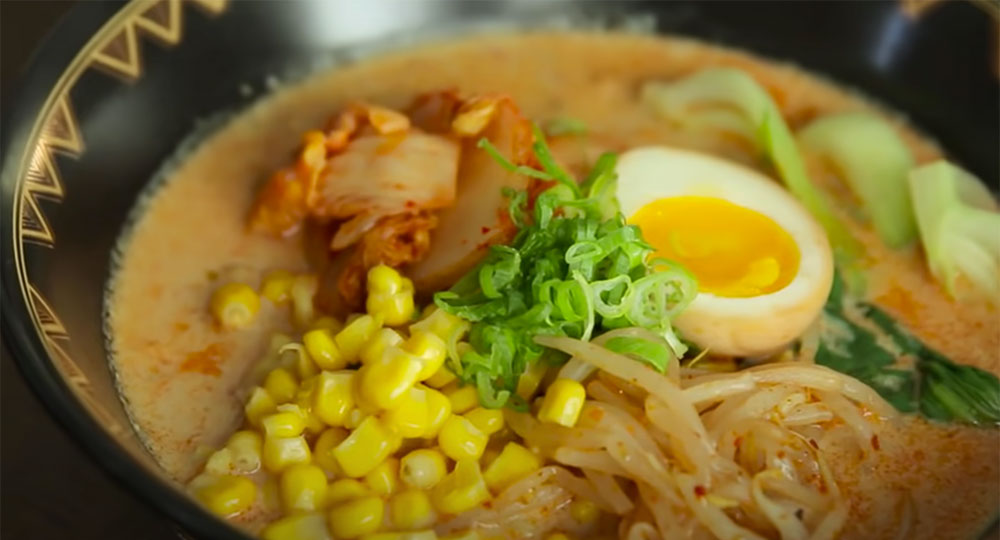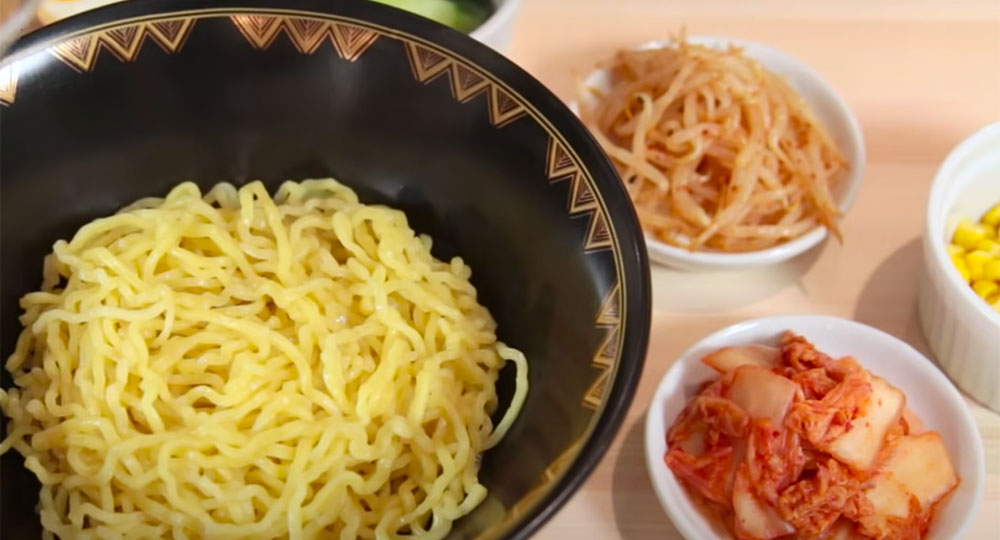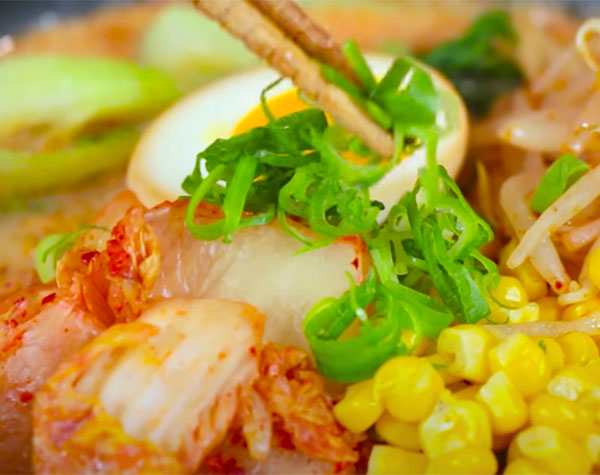
Sambar: A Culinary Icon of South India
August 14, 2024
Ragi Ladoo
August 31, 2024
Sambar: A Culinary Icon of South India
August 14, 2024
Ragi Ladoo
August 31, 2024
A Delicious and Nourishing Recipe
Ramen, a beloved Japanese noodle soup, has captured the hearts and taste buds of people around the world. Traditionally made with a rich broth, noodles, and an assortment of toppings, ramen is a comforting and versatile dish. However, as dietary preferences shift and more people embrace plant-based eating, Japanese vegetarian ramen has emerged as a popular alternative. This essay explores the essence of Japanese vegetarian ramen, focusing on the key elements of a vegetarian recipe that retains the depth and flavor of traditional ramen while catering to a plant-based diet.
50 Mins
Easy
Serves 6
The Essence of Ramen
Ramen is more than just a bowl of noodles; it is a harmonious blend of flavors and textures. The key components of any ramen dish include the broth, noodles, and toppings, each playing a crucial role in creating a balanced and satisfying meal. In traditional ramen, the broth is often made with meat or fish, providing a rich umami flavor. However, vegetarian ramen relies on plant-based ingredients to achieve a similar depth of flavor, proving that meat is not essential for creating a delicious bowl of ramen.
The Vegetarian Broth
The broth is the heart of any ramen dish, and in a vegetarian recipe, it must be carefully crafted to provide the same rich, savory base. A common approach to vegetarian ramen broth involves using a combination of ingredients that are naturally rich in umami, the fifth basic taste often described as "savory" or "meaty."
Kombu, a type of dried seaweed, is a popular base for vegetarian ramen broth. When simmered in water, kombu releases glutamates that provide a deep umami flavor. Shiitake mushrooms, known for their earthy and savory taste, are another key ingredient that enhances the broth. These mushrooms not only contribute umami but also add a rich, almost meaty texture to the soup.
Miso, a fermented soybean paste, is another essential ingredient in vegetarian ramen broth. Miso adds a complex, slightly tangy flavor that complements the other ingredients, creating a well-rounded and satisfying broth. Soy sauce, often used in combination with miso, adds saltiness and depth, balancing the flavors.

Noodles: The Foundation
Ramen noodles are typically made from wheat flour, water, salt, and kansui, an alkaline mineral water that gives the noodles their characteristic chewiness and yellow color. In a vegetarian ramen recipe, the noodles remain the same, as they are usually egg-free. However, for those with specific dietary needs, gluten-free or whole grain noodles can be substituted without compromising the dish's integrity.
The noodles should be cooked just before serving to ensure they retain their texture. When properly prepared, they provide a satisfying base that absorbs the flavors of the broth and complements the various toppings.
Toppings: A Symphony of Flavors and Textures
One of the most appealing aspects of ramen is the variety of toppings that can be added, allowing for endless customization. In vegetarian ramen, toppings are an opportunity to introduce a range of flavors, colors, and textures, making the dish both visually appealing and nutritionally balanced.
Tofu, a staple in vegetarian cuisine, is a common topping in vegetarian ramen. It can be prepared in various ways, such as lightly fried for a crispy texture or marinated for added flavor. Soft tofu can also be added directly to the broth for a silky, smooth texture.
Vegetables play a significant role in vegetarian ramen, both as toppings and as part of the broth. Bok choy, spinach, and kale add a vibrant green color and a slightly bitter taste that contrasts nicely with the rich broth. Corn adds sweetness and a burst of color, while bamboo shoots provide a crunchy texture.
Seaweed, particularly nori or wakame, is a traditional topping that enhances the umami flavor and adds a touch of the ocean to the dish. For an extra layer of flavor, vegetarian ramen can also be garnished with sesame seeds, green onions, pickled ginger, or a drizzle of chili oil.
Seasoning and Presentation
The final touch in a vegetarian ramen recipe is the seasoning. Garlic and ginger are commonly used to enhance the broth's flavor, while sesame oil adds a rich, nutty aroma. Chili oil or togarashi (Japanese chili powder) can be added for those who prefer a bit of heat.
Presentation is also important in ramen. The toppings should be arranged artfully, creating a balance of colors and textures that makes the dish as visually appealing as it is delicious. The broth should be poured over the noodles just before serving, ensuring that everything is piping hot and ready to enjoy.
Conclusion
Japanese vegetarian ramen is a delicious and nourishing dish that showcases the versatility of plant-based ingredients. By focusing on the key elements of broth, noodles, and toppings, this vegetarian recipe retains the depth and flavor of traditional ramen while catering to those who prefer a meat-free diet. Whether enjoyed as a comforting meal on a cold day or as a satisfying dish any time of the year, vegetarian ramen offers a delightful balance of flavors and textures that is sure to please both vegetarians and non-vegetarians alike.
How to cook Sambar?
Cooking Japanese vegetarian ramen at home is a rewarding experience that allows you to enjoy a flavorful and satisfying bowl of ramen tailored to your preferences. Here's a step-by-step guide to making delicious Japanese vegetarian ramen.
Ingredients:
For the Broth:
- 4 cups vegetable broth
- 2 cups water
- 1 piece of kombu (dried kelp)
- 4-5 dried shiitake mushrooms
- 3 tablespoons soy sauce
- 2 tablespoons miso paste (white or red)
- 1 tablespoon mirin (optional, for a slight sweetness)
- 1 clove garlic, minced
- 1-inch piece of ginger, sliced
- 1 tablespoon sesame oil
For the Noodles:
- 2 servings of ramen noodles (wheat-based, or gluten-free if preferred)
For the Toppings:
- 1 cup tofu, cubed and lightly fried or marinated
- 1/2 cup bok choy or spinach
- 1/4 cup corn kernels (fresh or frozen)
- 1/4 cup bamboo shoots
- 2-3 sheets nori (seaweed), cut into strips
- 2 green onions, sliced
- 1 tablespoon sesame seeds
- Chili oil or togarashi (Japanese chili powder) for spice (optional)
Preparation Steps:
1. Prepare the Broth
-
Soak the Kombu and Shiitake Mushrooms:
- Place the kombu and dried shiitake mushrooms in a pot with 2 cups of water. Allow them to soak for about 30 minutes to an hour. This helps release their umami flavor.
-
Simmer the Broth:
- After soaking, add the vegetable broth to the pot with the kombu and mushrooms. Bring the mixture to a gentle simmer over medium heat. Do not let it boil, as this can make the broth bitter.
- Add the garlic, ginger, soy sauce, and mirin (if using). Simmer for about 15-20 minutes, allowing the flavors to meld together.
- Remove the kombu and mushrooms from the pot. Slice the mushrooms thinly and set them aside to use as toppings later.
-
Add Miso Paste:
- In a small bowl, mix the miso paste with a bit of hot broth to dissolve it. Once dissolved, stir the miso mixture back into the pot. Avoid boiling the broth after adding the miso, as high heat can destroy its beneficial enzymes and alter the flavor.
2. Cook the Noodles
- Boil the Noodles:
- Bring a separate pot of water to a boil. Add the ramen noodles and cook according to the package instructions, usually around 3-5 minutes.
- Once cooked, drain the noodles and rinse them under cold water to stop the cooking process. Set aside.
3. Prepare the Toppings
-
Fry the Tofu:
- If using tofu, heat a small amount of sesame oil in a pan over medium heat. Add the cubed tofu and fry until golden brown on all sides. You can also marinate the tofu in soy sauce, ginger, and garlic for extra flavor before frying.
-
Blanch the Vegetables:
- In the same pot of water used for the noodles, blanch the bok choy or spinach for about 30 seconds, until they are bright green and tender. Remove and set aside.
4. Assemble the Ramen
-
Divide the Noodles:
- Divide the cooked noodles between two bowls.
-
Add the Broth:
- Pour the hot broth over the noodles in each bowl.
-
Add the Toppings:
- Arrange the sliced shiitake mushrooms, fried tofu, blanched bok choy or spinach, corn, bamboo shoots, and nori strips on top of the noodles.
- Sprinkle with sliced green onions and sesame seeds.
-
Season:
- If desired, drizzle with chili oil or sprinkle with togarashi for a spicy kick.
5. Serve and Enjoy
- Serve the vegetarian ramen immediately while it's hot. Enjoy the harmonious blend of flavors and textures in each comforting bite.
Tips and Variations
- Customize the Toppings: Feel free to add or substitute other vegetables and toppings based on your preference, such as carrots, bean sprouts, or even avocado slices.
- Experiment with the Broth: You can add other ingredients like miso varieties (white, yellow, or red), soy milk for creaminess, or different types of mushrooms to vary the flavor profile.
- Spice it Up: If you like your ramen spicy, consider adding a dollop of chili paste or sriracha to the broth before serving.
This Japanese vegetarian ramen recipe is a versatile and delicious way to enjoy the flavors of traditional ramen while adhering to a plant-based diet. With its rich broth, chewy noodles, and an array of fresh toppings, this dish is sure to satisfy your ramen cravings.

